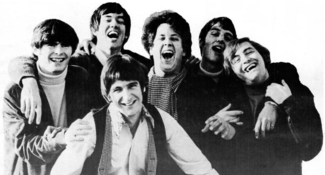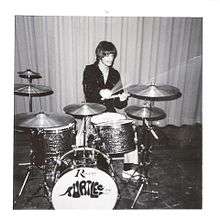John Barbata
| John Barbata | |
|---|---|
 Johny Barbata at 69 years old | |
| Background information | |
| Born |
April 1, 1945 Passaic, New Jersey, United States |
| Genres | Pop, pop rock, rock and roll |
| Occupation(s) | Musician |
| Instruments | Drums |
| Years active | 1961–present |
| Associated acts | The Turtles, Jefferson Airplane, Jefferson Starship, Crosby, Stills, Nash & Young |
John "Johny" Barbata (born April 1, 1945) is an American drummer, born in Passaic, New Jersey, and raised in San Luis Obispo, California, active especially in pop and rock bands in the 1960s and 1970s, both as a band member and as a session drummer. Barbata has served as the drummer for The Turtles, Crosby, Stills, Nash & Young, Jefferson Airplane (for its final album and tour only), Jefferson Starship (from 1974 to 1978), and Sammy & the Holly Rebs with guitarist Sam DeLuca. Already an established session drummer when he joined The Turtles, Barbata was one of the pioneering drummers who converted pop music rhythms from the down-beat rhythms of the 1950s to the off-beat rhythms that have dominated ever since.[1]
Early life
Barbata was born on Easter Sunday 1 April 1945, in Passaic, New Jersey, to Martina and Charles Barbata. He was raised in Saranac Lake, NY till the age of seven and later in Nutley, NJ. His mother was an Austrian emigrant who worked as a records keeper at a hospital and his father was a firefighter and mechanic. He was the youngest child of three, preceded by his older brother Chuck and sister Lauren. His first claim to fame came to him as a young infant when his mother found a man stranded in a boat that had run out of gas. The man was Albert Einstein. Einstein held the child as Barbata’s mother delivered them to shore.
Barbata’s interest in percussion began as he watched his older brother drumming in the marching band. After expressing interest in drums, Barbata’s brother brought him to a friend’s house where Barbata played on his first trap set. The first song he ever learned to play was “Put Another Nickel in” by Teresa Brewer.[2]
The Sentinals
At the age of 16, Barbata’s family relocated for a brief stint to Rialto, CA where Barbata formed his first band called the Velvatones. Soon after the family moved to San Luis Obispo, CA where Barbata went to high school and followed in his older brother’s footsteps and joined the marching band. The rudimentary rhythms and beats from Barbata’s time in drum line heavily influenced his technique in later years. He soon went on to help form a band called the Ambassadors and bought his first set of drums. After playing gigs every weekend for 6 months, Barbata was approached by an instrumental surf rock group called the Sentinals to play drums. The Sentinals toured all over the country with acts such as the Righteous Brothers and released the album Big Surf which produced a #1 West Coast surf hit called “Latin’ia”.[3]
After five years with the Sentinals, the band broke up, and Barbata along with his band mate, Lee Michaels, headed out to Hollywood. Shortly after, Barbata joined Joel Scott Hill of Canned Heat, after his drummer left and went on to play with the Mamas and Papas. Joel, Barbata, and Chris Ethridge later went on to put out the album L.A. Getaway in 1971.
The Turtles (1966-1970)
In the Spring of 1966, The Turtles were looking for a new drummer and Gene Clark of the Byrds recommended Barbata. After an audition with Howard Kaylan, Mark Volman, and Al Nichol, Barbata had the gig. The first song Barbata recorded with the Turtles was “Happy Together” and on March 25, 1967 “Happy Together” went to #1 on the charts.
His most famous band memberships have been:
Other notable collaborations include:
- With The Strangers guitarist Joel Scott Hill and bassist Bob Mosley
- With other Jefferson Airplane members as session musicians on ex-member Grace Slick's album Manhole.
- Session musician for
- Leon Russell
- Dave Mason
- ...and others, with over 60 albums to his "uncredited" credit.
References
- ↑ Barbata, Johny Barbata (2007). The Legendary Life of a Rock Star Drummer. DJ Blues Publishing Co. ISBN 7774585796.
- ↑ Barbata, Johny (2007). The Legendary Life of a Rock Star Drummer. DJ Blues Publishing Co. ISBN 7774585796.
- ↑ Barbata, Johny (2007). The Legendary Life of a Rock Star Drummer. DJ Blues Publishing Co. ISBN 7774585796.


External links
- Johny Barbata's official website
- 2005 Johny Barbata interview with Jon Niccum